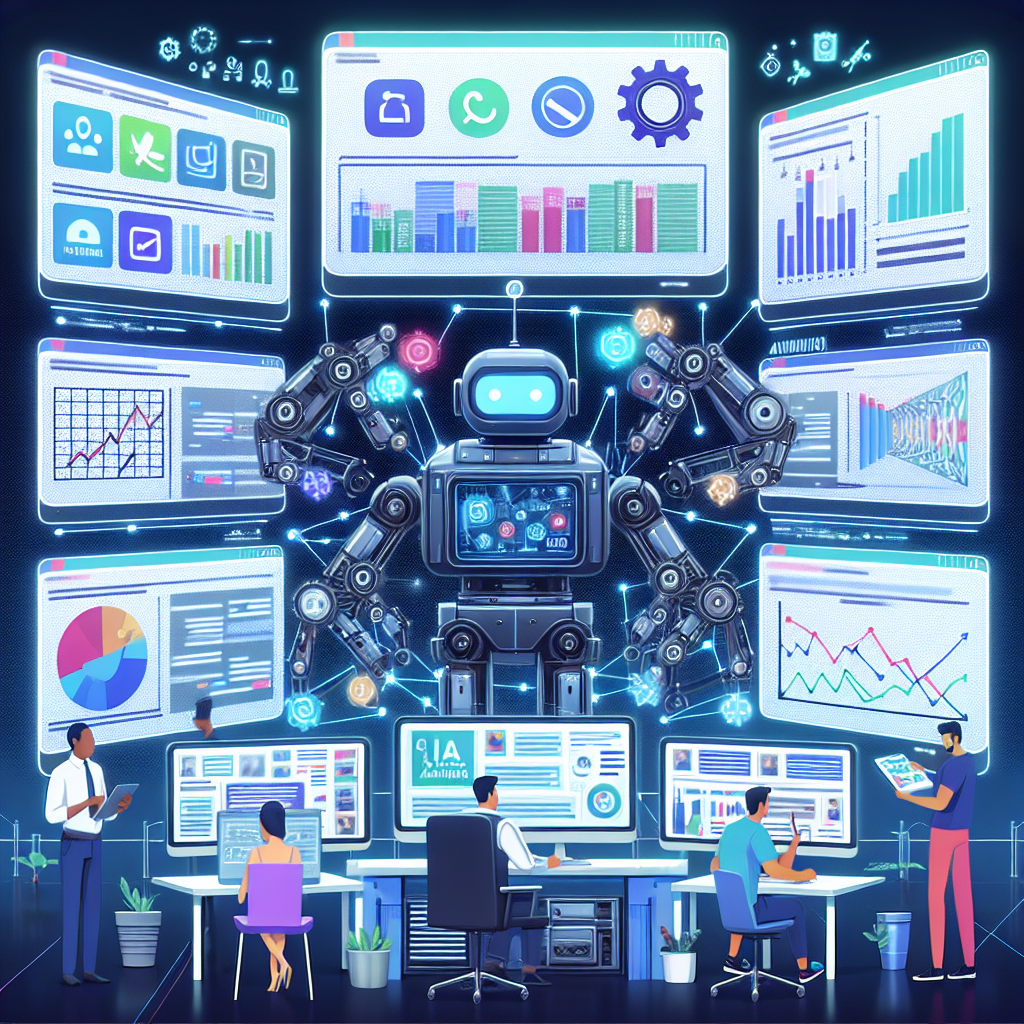
Automate Ad Spend Adjustments Across Platforms with AI Tools
- Ad Spend Automation Strategies
- AI Tools for Multi-Platform Management
- Benefits of Automation in Advertising
- Real-World Examples of Automated Ad Spend
Ad Spend Automation Strategies
Understanding Your Ad Spend Goals
Before I even think about automating anything, I’ve got to nail down what I want to achieve. Understanding my ad spend goals is the first step. This means diving deep into my campaign objectives. Am I looking to increase sales, drive brand awareness, or maybe something else? Having clear goals helps me to track the performance and ascertain ROI down the line.
Knowledge of my audience also plays a crucial role. I take the time to analyze who I’m targeting. Am I after millennials, busy professionals, or tech enthusiasts? Defining this helps me craft compelling ads that are more likely to convert. Keeping my audience in mind allows me to adjust my ad spend where it matters most, ensuring I’m not just throwing money at random ads.
Lastly, I don’t just set it and forget it. I continually review and tweak my strategy as needed. This includes regularly checking if my objectives are still aligned with my goals. The flexibility to adjust my campaign as I go is super important, especially in our fast-paced digital world.
Choosing the Right Algorithms
When considering automation, I prioritize selecting the proper algorithms that fit my needs. It’s a bit like picking the right tool from a toolbox. Different algorithms have unique functionalities, and my choice can significantly influence my ad spend effectiveness.
I often look into machine learning algorithms that can analyze vast amounts of data quickly. This way, the system can make real-time adjustments based on campaign performance. Finding the right balance between automation and human oversight can lead to amazing results.
Additionally, I pay attention to algorithm updates. These tools are constantly evolving, and keeping up with changes ensures I’m utilizing their full potential. Knowing when to adapt and implement new techniques can provide a valuable edge in my advertising game.
Implementing Automation Tools
Implementing automation tools can feel like a daunting task at first, but it’s incredibly rewarding. I take it step-by-step: starting with one platform and slowly expanding as I get comfortable. It’s essential to ensure these tools align with my specific objectives.
Once I’ve set up my automation, I like to monitor closely at the beginning. It helps to catch any unforeseen hiccups. Surprisingly, I often discover that minor adjustments at the outset can set the stage for long-term success.
Along the journey, I’ve learned to trust my tools but also my instincts. Sometimes, automated decisions don’t hit the mark. Staying engaged and ready to intervene when necessary is key to truly harnessing the power of automation.
AI Tools for Multi-Platform Management
Understanding Multi-Platform Dynamics
Understanding how different platforms interact is vital when managing multiple channels. I’ve worked with several social media platforms, Google Ads, and email marketing, and each has its unique character and audience. I take time to study how ad spend behaves across these platforms, as it can change dramatically.
For example, what might work well on Instagram doesn’t always translate to Facebook. Knowing the nuances helps me allocate my budget in a way that capitalizes on each platform’s strengths. It’s crucial to have a bird’s-eye view of where my budget is being spent, helping me avoid wasting money in places that aren’t delivering.
Additionally, keeping an updated dashboard can help. I like to create visual representations of my data to see everything at a glance. Sometimes, a graph can tell me what words can’t – dramatizing how perfectly or poorly a campaign is doing.
Integration of Tools
Integration is where the magic happens. I prefer to choose AI tools that sync seamlessly across various platforms. The ability to manage my ad spend from one central hub not only saves me time but also ensures consistency in my messaging.
When I integrate tools, I can create automated workflows that help me deploy campaigns more efficiently. For example, if a particular ad performs well on one platform, I can quickly scale it up across others without having to start from scratch. This flexibility gives me an edge, especially when trends shift overnight.
It’s not without its challenges, though. Each tool comes with its own learning curve, so I make it a point to dedicate time to fully understand how they work together. I believe it’s all about trial and error; if something doesn’t fit, I can shift gears and try another solution quickly.
Leveraging Data Insights
This is where AI tools really shine for me. They help parse through heaps of data to spot trends and insights I might miss if I were looking at things manually. I used to drown in spreadsheets, hoping to make sense of my ad spend, but with AI, it’s a whole different ball game.
Every click, every impression, and every penny spent can be analyzed to inform future decisions. I’m all about using this data to tailor not just my ads but my entire approach. If something isn’t working or showing promise, I want to know fast, so I can adjust my strategy on the fly.
Data-driven decision-making has become my go-to. I trust the numbers, but I also don’t ignore my instincts. Combining the two has, over time, led to some pretty significant gains in my advertising success.
Benefits of Automation in Advertising
Time Efficiency
One of the most significant benefits I’ve found with automation is the time I save. Ad campaigns can be a full-time job in themselves, and manually adjusting bids or budgets was exhausting. But with automation, I spend less time on repetitive tasks and more on strategizing my next move.
I can set parameters and let the system do its thing, knowing it can adapt almost instantaneously to changes in performance. Whether it’s pausing underperforming ads or reallocating spend to high performers, this instant turnaround is a game changer for me.
With the extra time I’ve gained, I can focus on creative aspects and analyze campaign effectiveness without feeling rushed. Giving myself this time to breathe has ignited my passion for marketing all over again.
Increased Accuracy
Automation brings a level of precision that is hard to match. I sometimes slip up when manually adjusting bids or budgets – we’re all human, after all! But with smart algorithms managing my ad spend, the likelihood of error significantly reduces.
AI tools analyze performance data on a scale that’s just not possible for me alone. They consider hundreds of variables and make adjustments based on optimal performance metrics. I’ve found that this results in better ad placements and ultimately leads to a higher return on investment.
The combination of speed and accuracy has become vital in my advertising strategy. I can trust that my budget is being managed effectively, leaving me to focus more on creative innovation rather than getting bogged down in details.
Scalability of Campaigns
When I’m ready to scale up my campaigns, automation allows for smooth transitions. Implementing larger budgets or launching new ad sets used to be a logistical nightmare, but not anymore. With automation, I can easily duplicate successful campaigns across platforms with minimal hassle.
This scalability means that as my business grows, my advertising efforts can grow right alongside it. If I see success in one area, I don’t have to hesitate about scaling; the process is automated, and everything’s aligned well to handle the influx of traffic.
Taking my advertising to new heights feels less daunting now. I’m excited to explore new ideas, knowing that I have automation backing me up behind the scenes.
Real-World Examples of Automated Ad Spend
Case Study: E-Commerce Success
I remember diving into the world of e-commerce a few years ago. A client of mine was struggling with manual bidding and unclear ROI. By employing AI tools to automate their ad spend across major platforms, we quickly saw improvement. The algorithms analyzed patterns and helped refine targeting—leading to a notable rise in conversions.
This case reminded me how crucial automation is even for small businesses. The ease of management and clear data insights helped streamline processes and focus on growth. The best part? The client loved seeing metrics in real time, boosting their confidence to invest even more into their campaigns.
Automation isn’t just for big players; even smaller businesses can reap the rewards if they approach it intelligently.
Case Study: Non-Profit Campaign
In a particular non-profit campaign I worked on, we faced a unique challenge. With limited resources, every cent counted. By automating our ad spend with tools that adjusted in real time based on engagement, we managed to stretch our budget further than ever before.
We ran ads on social media and Google, and the system helped us maximize reach without overspending. The resulting increase in donations was fantastic, proving that every organization can benefit from smart ad spend management.
Seeing the direct impact our strategies had on such a meaningful cause filled my heart with pride and reinforced the importance of technological advancement in all sectors.
Case Study: Influencer Promotions
I also dabbled in coordinating influencer promotions, which brings its own challenges regarding ad spend. In this scenario, utilizing automation was key. We tracked performance in real-time, adjusting our spend based on immediate feedback.
The agility of our approach allowed us to pivot quickly if a campaign underperformed. Instead of waiting weeks for a review, we capitalized on opportunities right away. The experience not only taught me about the nuances of influencer marketing but also emphasized the necessity of swift decision-making in today’s advertising world.
Success can be defined in many ways, but the ability to adapt quickly with an automated system has proven vital in finding out what works best during a campaign!
FAQ
What are the main benefits of automating ad spend?
The primary benefits include time efficiency, increased accuracy in targeting, and the ability to scale campaigns quickly. Automation allows for real-time adjustments and data-driven decisions that improve overall campaign performance.
Which AI tools are recommended for managing ad spend?
There are several great options like Google Ads Smart Bidding, AdRoll, and HubSpot Ads. The key is to choose tools that integrate well with your existing platforms and align with your specific advertising goals.
Can small businesses successfully use automated ad tools?
Absolutely! Automation isn’t just for large corporations. Many small businesses can achieve incredible results by using AI tools to manage their ad spend efficiently and effectively, allowing them to compete with larger brands.
How can I measure the success of my automated ad campaigns?
You can measure success through various metrics like conversion rates, ROI, and click-through rates (CTR). Utilizing analytics dashboards will help you track these metrics and adjust your strategy as needed to stay aligned with your goals.
Get it now, your new content producer, that makes your journey so much easier.
This is a wonderfull resource it makes all the difference to your product creation and sales, even giving you a market place to list and sell your product.

